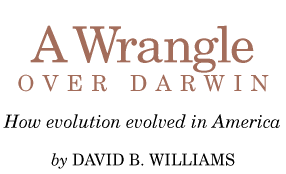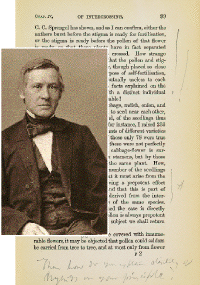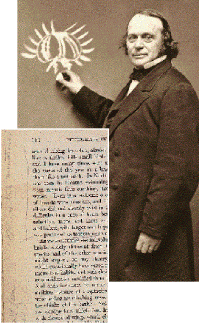Main Menu · Search ·Current Issue ·Contact ·Archives ·Centennial ·Letters to the Editor ·FAQs

|
Of the several thousand letters that charles darwin wrote during his lifetime, few were more important than one he sent on September 5, 1857, to Harvard botanist Asa Gray. Darwin wrote in his semi-legible scrawl: "I will enclose the briefest abstract of my notions on the means by which nature makes her species....I ask you not to mention my doctrine." Asa Gray thus became the first person in North America to learn about Darwin's ideas on natural selection.
Darwin revealed his theory to the general public two years later in his revolutionary book, On the Origin of Species. Its publication prompted fierce debate in this country. On one side arose Gray, Darwin's friend and supporter, a taciturn man best known as a cataloguer and collector of plants. In opposition stood Gray's Harvard colleague Louis Agassiz, a charming, brilliant lecturer and the most popular scientist in the land. Harvard thus became the most important battleground in the initial American engagement with natural selection.
~~~
Asa Gray was Fisher professor of natural history at Harvard from 1842 till 1873. Although he was originally trained as a medical doctor, his passion was plants. His reputation as a taxonomist helped him establish one of America's premier collections of dried plants, which contained material from collectors who had traveled in the United States and around the world. By the early 1860s, his personal herbarium totaled almost 200,000 specimens.
Gray and Darwin's epistolary relationship began in 1855, when Darwin wrote Gray. As usual with Darwin, he was humble, and he wanted information. The Englishman asked the American about alpine plants in the United States and their relationship to plants in Europe and Asia. During the next few years, Gray used his vast collection to provide much-needed information on two topics essential to Darwin's theory--the distribution of plants, and variation in wild, non-domesticated species.
 Gray in 1865. His copy of Origin, with marginalia, is in the Gray Herbarium. ARCHIVES AT THE GRAY HERBARIUM, HARVARD UNIVERSITY
Gray in 1865. His copy of Origin, with marginalia, is in the Gray Herbarium. ARCHIVES AT THE GRAY HERBARIUM, HARVARD UNIVERSITY |
Despite Gray's world renown as a botanist, his colleague Louis Agassiz, professor of zoology and geology, commanded most of the scientific attention in Cambridge. Respected by scientists and liked by the general public, Agassiz was also friends with the Boston literati, among them Ralph Waldo Emerson, James Russell Lowell, and Oliver Wendell Holmes. Of Swiss origin, Agassiz had made his mark in science in 1840 with his best-known book, Études sur les glaciers. In it he proposed the then-unorthodox theory that great glaciers had once covered and carved northern Europe.
Agassiz first came to this country in 1846, to present a series of lectures in Boston. As many as 5,000 people a night attended his talks on subjects as diverse as fossil fishes, the Ice Age, and embryology. In 1847, Harvard wooed him away from Europe. The most important North American scientific periodical of the day, the American Journal of Science, reported, "Every scientific man in America will be rejoiced to hear so unexpected a piece of news." In the following years, Agassiz continued to make science accessible to the public through lectures, books, and articles.
~~~
On November 11, 1859, Darwin began the arduous task of gaining support for the imminent publication of Origin of Species. (Not that sales mattered to him financially; he was independently wealthy. Nevertheless, he would receive two-thirds of the net profit!) Like any modern author, he asked his publisher, John Murray of London, to send presentation copies to potential reviewers.
He also wrote personal notes to 11 of the most important scientists of the day. The majority of these letters acknowledged that the recipient would not support Darwin's theory of natural selection. In one letter he wrote: "How savage you will be, if you read it, and how you will long to crucify me alive!!" But Darwin also tried to push the veracity of his theory by writing later in the same letter, "I am fully convinced that you will become year after year, less fixed in your belief in the immutability of species."
Two of Darwin's November 11 letters crossed the Atlantic to Harvard. One went to Asa Gray and the other to Louis Agassiz. The letters are now preserved in the Gray Herbarium Library and the Houghton Library.
Agassiz's letter is short, only three sentences. Darwin knew that Agassiz would not agree with his theory. He wrote: "As the conclusions at which I have arrived on several points differ so widely from yours,...I hope that you will at least give me credit, however erroneous you may think my conclusion, for having earnestly endeavored to arrive at the truth." Agassiz did not reply to Darwin, who did not send him another letter until 1868.
In contrast, the letter to Gray (at top right) covers almost two full pages. Again Darwin is humble, and seeks out Gray's approval, but he is also proud of the book. "If ever you do read it, & can screw out the time to send me...however short a note...I should be extremely grateful," he writes. In a postscript Darwin adds "...I cannot possibly believe that a false theory would explain so many classes of facts."
 Agassiz, about 1861, and a page from his copy, at the Museum of Comparative Zoology. ERNST MAYR LIBRARY OF THE MUSEUM OF COMPARATIVE ZOOLOGY, HARVARD UNIVERSITY
Agassiz, about 1861, and a page from his copy, at the Museum of Comparative Zoology. ERNST MAYR LIBRARY OF THE MUSEUM OF COMPARATIVE ZOOLOGY, HARVARD UNIVERSITY |
Agassiz and Gray received their copies of Origin in late December. Gray peppered the margins of the small green book with "Yes," "Well put," and numerous exclamation points. He clearly approved of Darwin's overall tone and reasoning. On the other hand, Agassiz's marginalia range from "This is truly monstrous" to "The mistake of Darwin..." to "A sentence likely to mislead!"-- notes that he elaborated on later in his more formal criticism of Darwin and his theory.
Professionally, the two men generally kept their comments about each other's reaction to Darwin's theory on a high level. Personally, they remained distant, indulging in a few caustic remarks to friends. On January 5, 1860, for example, Gray wrote a detailed letter about the American response to Origin of Species to the English botanist Joseph Hooker. In describing his own feelings, Gray wrote: "It is crammed full of most interesting matter--thoroughly digested--well expressed--close, cogent; and taken as a system it makes out a better case than I had supposed possible." Several paragraphs later he described a much different response from Agassiz: "...when I saw him last, [he] had read but part of it. He says it is poor--very poor!! (entre nous). The fact [is] he growls over it much like a well cudgeled dog [and] is very much annoyed by it."
~~~
Agassiz launched his public attack on Darwin at the American Academy of Arts and Sciences, Boston's most important learned society. He told the group gathered on January 10, 1860, that modern species and fossil species had no genetic relationship. This tenet was central to the theory of special creationism, which held that God had created each and every species in its current location. Species did not change through time, but they did become extinct. Great catastrophes, like floods or the glaciers described by Agassiz in Études, had periodically destroyed life on earth. The fossil record indicated at least 48 successive periods of change, according to Agassiz.
He clarified his position a month later and condemned one of Darwin's pivotal themes--variation within species. America's foremost zoologist denied the "existence of varieties, properly so called, in the animal kingdom." Instead, Agassiz viewed variation within species as merely a stage of growth or a cycle of development. God had created the species; therefore they were immutable. In addition to this line of attack, Agassiz categorically rejected Darwin's use of domesticated animals as an example of change over time.
By mid summer Agassiz had clearly defined his position: he stood resolutely on the side of special creationism and against Darwin. Agassiz realized that some would question his statements, but knew that "after mature examination of the facts they would be generally received." In July 1860, he concluded his review of Origin of Species in the American Journal of Science by writing, "I shall therefore consider the transmutation theory a scientific mistake, untrue in facts, unscientific in its methods, and mischievous in its tendency."
Gray began his public defense of Darwin, also in the American Journal of Science, with a positive review of Origin in the March 1860 issue. He wrote that Darwin's ideas on variation within plants and animals were "general, and even universal." He supported the English naturalist's use of domesticated animals as examples, and believed that Darwin's various associations of facts "[seem] fair and natural."
Although Gray vigorously defended Darwin and natural selection in this review, in a three-part series in the Atlantic Monthly, and throughout the springtime debates at Boston's learned societies, he, like Agassiz, maintained a link between a supreme power and natural selection. Gray did not support Agassiz's brand of special creationism, but did believe "that variation has been led along certain beneficial lines" by the hands of a creator. Natural selection occurred, but God played some not clearly defined role in the process.
Darwin never supported these statements on the role of a higher power. He wrote Gray: "I grieve to say that I am in an utterly hopeless muddle. I cannot think that the world, as we see it, is the result of chance; & yet I cannot look at each separate thing as a result of Design."
Darwin did, however, realize the importance of Gray's thesis in the developing battle between religion and science. (The bishop of Oxford popularized this debate in June 1860 by asking Darwin's main supporter in England, Thomas Huxley, "Was it through his grandfather or his grandmother
that he claimed his descent from a monkey?") With Darwin's assistance, Gray's Atlantic pieces, which contained his most cogent explanations for natural selection and Design, reached England as a small pamphlet bearing the Darwin-suggested motto, "Natural Selection not inconsistent with Natural Theology."
Despite Gray's strong religious feelings, he was at heart a scientist. Unlike Agassiz, he could separate his faith and his science. Gray ultimately concluded that "The work [Origin] is a scientific one...and by its science it must stand or fall."
~~~
For Gray, 1860 was the most important year of the Darwinian debate. He would continue occasionally to write and speak out on the subject, but never as vigorously as during the first eight months of the decade. The controversy had taken him away from his beloved plants. He returned to his work of identifying and cataloguing, and to the next edition of his and John Torrey's Manual of Botany. In 1864 he donated his library and plant specimens to Harvard; they became the nucleus of the Gray Herbarium. He continued to correspond with Darwin, whose work began to address many botanical problems, including carnivorous plants. They remained friends until Darwin died in 1882.
As a committed anti-evolutionist, Agassiz continued to oppose Darwin for the rest of his career. He presented three lecture courses and published 21 articles and three books between 1861 and 1866 extolling special creationism. None of these, however, were in professional or scientific journals. Despite his growing popularity with the general public, Agassiz's influence in the scientific debate over evolution faded. When he died, in 1873, he was one of the last, and certainly the most important, of the scientists who subscribed to special creationism.
Ironically, Agassiz is one of the main reasons that Harvard remains a center for evolutionary studies. The worldwide scope of the animal and fossil collections at the Museum of Comparative Zoology, which Agassiz established and directed, combined with the specimens housed in the Gray Herbarium, facilitate ongoing research into questions of natural selection and speciation. In spite of their differences, both Gray and Agassiz shared a profound respect for the scientific method. Their rigorous examination of plants and animals laid the groundwork for the eventual acceptance of Charles Darwin's theory of evolution.